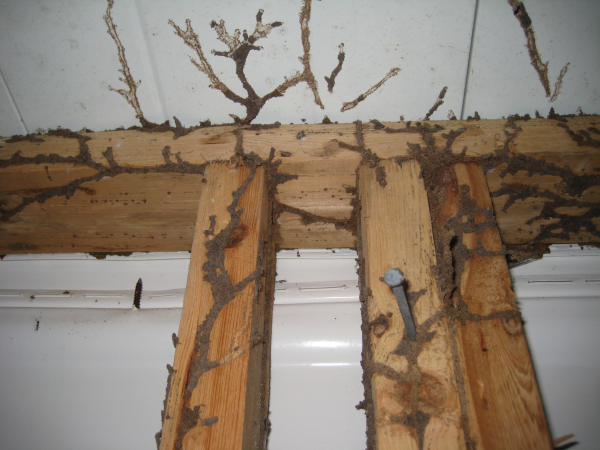In order to determine the signs of a termite infestation, you first need to understand what a termite is and what they’re all about.
What do termites look like?
Depending on your geographical location, the way termites look as well as their habits may vary. In Northwest Indiana, we see quite a bit of homes with active termite colonies as well as homes with old damage from prior infestations. I know, we never think it’ll happen to our house. And that’s totally fine to think positively like that! But just in case, you didn’t already know what they look like, here are some pictures of termites. They’re different members of a subterranean colony.
Formosan Subterranean Termite
Subterranean Termites
Soldier Termite
Termite Swarmer
Where do termites live?
You usually won’t see subterranean termites. They build these massive colonies underground. Tunnels and chambers and channels…OH MY! Using mud tubes, they gain access to food (they love the cellulose that’s in wood). When wood becomes rotten or water-logged, it’s even more attractive to them.
Termites keep themselves pretty well protected in their tubular colonies away from human or animal disturbance. Their colonies have to be touching soil for it to survive and thrive, so it’s possible in springtime when you’re trying to plant flowers that you end up digging up some chambers if there’s a colony present and thriving on your property. It’s not typically until the damage is already done to a house that they are discovered. That’s why they call them “Silent Destroyers”.
What are the signs of a termite infestation?
Let’s go over some of the warning signs of termite infestation.
- Mud Tubes
These are the tunnels that branch off the soil-level “highways” that termites use in order to forage for food and transport it throughout their colonies. These can be built in concrete cracks as well as along the walls of a structure. - Swarms (dark brown ant-like bugs with super long wings)
Termites swarm during springtime. Swarmers, or alates, are the darker colored winged reproductive termites. They leave their colony in search of new food sources to support a new colony location. And life continues… - Damaged wood structures
Termites leave behind sort of a signature look when they damage wood. Rows and crevices run deep, degrading the integrity of any structure. - Small off-white bugs that resemble maggots at first glance
These are the worker termites and the most abundant in quantity throughout a subterranean termite colony.
How much is my house at risk for getting termites?
Because there are multiple things that factor into what attracts termites, there’s such a thing as a Termite Risk Calculator. It’s basically a series of questions about your house, property, structural details and geographic region for factoring in the climate, of course. Do you have a few minutes? Click the map below and answer the questions now to see where your house ranks in the termite world.
How do I know which treatment for termites I should choose?
If you think (or for sure know) you have termites, it would be smart to begin getting quotes from pest control companies that are licensed for termite control. It sounds like that should be standard, but it’s actually a specialty category that operators are certified for, aside from common household pest control.
Don’t be afraid to ask questions. The better you can understand what treatment method is being proposed, the easier it will be for you to obtain peace of mind that your house isn’t going to fall apart from bugs. Am I right? Or am I right?
A lot of pest control companies in Indiana and the rest of the midwest offer two different types of treatment for termites.
- Conventional chemical barrier
This method has been around for decades and creates a liquid chemical barrier between the termites and the house. It usually expires after a certain amount of time, but will come with a guarantee. - Baiting system
This is your green termite control option. Brands like Sentricon now have a product that has been proven to be more desirable by termites than wood itself! Check out the following video to see how it works.
Honestly, this is where it’s ultimately up to your choice and preference in the interest of your property’s well-being. Of course, cost factors in, too. Need a quote?












